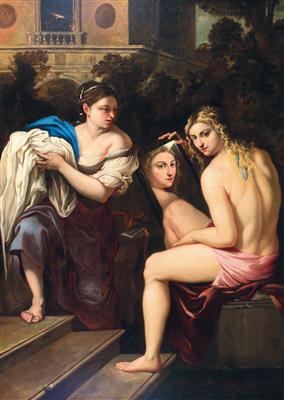Giacomo Farelli

(Rome 1629–1706 Naples)
Bathsheba at her bath,
oil on canvas, 200 x 130 cm, framed
We are grateful to Nicola Spinosa for confirming the attribution of the present painting on the basis of a high-resolution digital photograph and for his help in cataloguing this lot (written communication).
We are also grateful to Riccardo Lattuada for independently confirming the attribution after inspection of the present painting in the original.
The present, unpublished, painting belongs to the production of Giacomo Farelli, who was active in Naples throughout the second half of the seventeenth century and the early eighteenth century.
This work depicts an episode from the Old Testament, Book of Samuel (39:6-20) when King David sees the wife of a soldier, Bathsheba, from his palace window and becomes infatuated by her, eventually seducing her. The king later marries Bathsheba after her husband dies in battle and he asks God for forgiveness for his actions. Solomon was the result of their union and ascended to the throne of Jerusalem. Italian and European painters from the sixteenth century onwards frequently represented this subject, especially on account of the sensually erotic undertone with which the scene was interpreted, particularly during the baroque age. Many painters in Naples handled the subject between the seventeenth and eighteenth centuries, from Artemisia Gentileschi and Massimo Stanzione to Luca Giordano and Francesco Solimena.
Nicola Spinosa dates the present painting to around 1690, positioning it in the wake of Artemisia Gentileschi’s handling of the subject on the one hand, and on the other, as an anticipation of the transition from late baroque to classicising solutions, adopted at the turn of the century by artists such as Nicola Vaccaro, Francesco Solimena and Paolo De Matteis.
On account of its studied compositional clarity, its attention to the definition of volume and form, and its careful depiction of emotional reactions, the present painting reveals Farelli’s ability to reconcile the baroque language of Mattia Preti and Giordano, with the classicism of Stanzione and Andrea Vaccaro, who Farelli trained with on his arrival in Naples in his youth. Moreover, owing to its display of a rich pallet, the present work also reveals the artist’s recovery of certain aspects of the ‘neo-Venetian’ current of Cesare Fracanzano. These characteristics are also present in other paintings by Giacomo Farelli of biblical, historical and mythological subjects, such as the Sampson and Delilah or the Rape of the Sabines – each in a private collection – that were surely executed for erudite Italian and international patrons (see N. Spinosa, Pittura del Seicento a Napoli. Da Mattia Preti a Luca Giordano, Naples 2011, pp. 173-174).
23.10.2018 - 18:00
- Odhadní cena:
-
EUR 30.000,- do EUR 40.000,-
Giacomo Farelli
(Rome 1629–1706 Naples)
Bathsheba at her bath,
oil on canvas, 200 x 130 cm, framed
We are grateful to Nicola Spinosa for confirming the attribution of the present painting on the basis of a high-resolution digital photograph and for his help in cataloguing this lot (written communication).
We are also grateful to Riccardo Lattuada for independently confirming the attribution after inspection of the present painting in the original.
The present, unpublished, painting belongs to the production of Giacomo Farelli, who was active in Naples throughout the second half of the seventeenth century and the early eighteenth century.
This work depicts an episode from the Old Testament, Book of Samuel (39:6-20) when King David sees the wife of a soldier, Bathsheba, from his palace window and becomes infatuated by her, eventually seducing her. The king later marries Bathsheba after her husband dies in battle and he asks God for forgiveness for his actions. Solomon was the result of their union and ascended to the throne of Jerusalem. Italian and European painters from the sixteenth century onwards frequently represented this subject, especially on account of the sensually erotic undertone with which the scene was interpreted, particularly during the baroque age. Many painters in Naples handled the subject between the seventeenth and eighteenth centuries, from Artemisia Gentileschi and Massimo Stanzione to Luca Giordano and Francesco Solimena.
Nicola Spinosa dates the present painting to around 1690, positioning it in the wake of Artemisia Gentileschi’s handling of the subject on the one hand, and on the other, as an anticipation of the transition from late baroque to classicising solutions, adopted at the turn of the century by artists such as Nicola Vaccaro, Francesco Solimena and Paolo De Matteis.
On account of its studied compositional clarity, its attention to the definition of volume and form, and its careful depiction of emotional reactions, the present painting reveals Farelli’s ability to reconcile the baroque language of Mattia Preti and Giordano, with the classicism of Stanzione and Andrea Vaccaro, who Farelli trained with on his arrival in Naples in his youth. Moreover, owing to its display of a rich pallet, the present work also reveals the artist’s recovery of certain aspects of the ‘neo-Venetian’ current of Cesare Fracanzano. These characteristics are also present in other paintings by Giacomo Farelli of biblical, historical and mythological subjects, such as the Sampson and Delilah or the Rape of the Sabines – each in a private collection – that were surely executed for erudite Italian and international patrons (see N. Spinosa, Pittura del Seicento a Napoli. Da Mattia Preti a Luca Giordano, Naples 2011, pp. 173-174).
|
Horká linka kupujících
Po-Pá: 10.00 - 17.00
old.masters@dorotheum.at +43 1 515 60 403 |
| Aukce: | Obrazy starých mistrů |
| Typ aukce: | Salónní aukce |
| Datum: | 23.10.2018 - 18:00 |
| Místo konání aukce: | Wien | Palais Dorotheum |
| Prohlídka: | 13.10. - 23.10.2018 |
